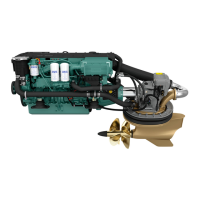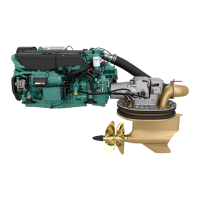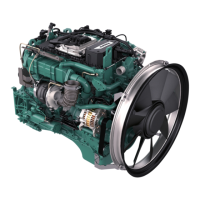Do you have a question about the Volvo Penta IPS and is the answer not in the manual?
Explains the meaning and priority of safety symbols used in the manual.
Advice for new boat owners on learning engine and boat handling.
Guidance on safe boat handling, avoiding sudden movements and propeller risks.
Information on the risks of carbon monoxide and how to mitigate them.
Importance of understanding the manual and seeking dealer assistance.
Safety measures related to fuel, oil, batteries, and electrical systems.
Details on engine warranty coverage and owner responsibilities.
Volvo Penta's commitment to environmental protection and user advice.
Information on maintaining the engine and using approved parts.
Description of the ignition lock positions and starting procedures.
Overview of the information panel, its displays, and settings.
Explanation of various gauges like fuel, voltage, temperature, and oil pressure.
Instructions for navigating and using the 4-inch display.
Guide to operating the 7-inch screen, including pop-up functions.
How to engage and disengage the low speed function for hydraulic transmissions.
Description of the sport fishing function for enhanced maneuverability.
Using the joystick for boat control in conjunction with autopilot.
Information on autopilot setup, navigation patterns, and course setting.
Pre-start checks including oil, coolant, fuel, and main switches.
Step-by-step guide for starting the engine using ignition or starter button.
How to monitor engine status and respond to alarms.
Proper procedures for shifting gears and manoeuvring the boat.
Changing, activating, and locking helm stations for multi-station control.
Methods for stopping the engine using key or stop button.
Post-shutdown checks including leak inspection and maintenance logging.
Understanding engine and EVC system warnings and fault messages.
Table of symptoms and possible causes of engine malfunctions.
Detailed descriptions of system messages and suggested actions.
Guidance for diagnosing faults in engine, fuel, transmission, and steering.
Procedure for starting the engine using auxiliary batteries safely.
Methods for steering the boat in case of primary steering system failure.
Tasks and intervals for the initial service inspection.
Scheduled maintenance tasks at specific hour or time intervals.
Visual checks of the engine and engine bay for leaks and wear.
Instructions for checking and changing drive belts.
Procedure for changing engine oil and filters.
Tasks related to fuel filters, bleeding, and water separators.
Information on coolant, mixing, checking levels, and system flushing.
Procedures for draining, checking anodes, and cleaning filters.
Guidelines for battery care, connecting/disconnecting, and charging.
Best practices for boat electrical systems to prevent corrosion.
Precautions and procedures for electrical welding near the engine.
Procedure for checking and topping up transmission oil level.
Steps for changing transmission oil and filter.
Checking and replacing sacrificial anodes for corrosion prevention.
Instructions for safely removing the propeller.
Steps for installing propellers, including torque specifications.
Guidelines for storing the boat for shorter periods.
Comprehensive checklist for long-term engine and boat preservation.
Tasks required to prepare the boat and engine after storage.
How to access and navigate through the system settings.
Personalizing displayed information in the 'My View' screen.
Setting the depth alarm level and offset for the echo sounder.
Adjusting screen contrast and panel backlighting for optimal viewing.
Configuring display units (metric/imperial) and language.
Methods for calibrating the fuel level sensor for accurate readings.
Procedure for calibrating the joystick if movements are not corresponding.
Technical details for IPS 900 and IPS 1050 engine models.
Oil capacity, pressure, quality, and viscosity recommendations.
Coolant capacity, types, and water quality requirements.
Location and importance of engine and propulsion unit identification plates.
Explains the meaning and priority of safety symbols used in the manual.
Advice for new boat owners on learning engine and boat handling.
Guidance on safe boat handling, avoiding sudden movements and propeller risks.
Information on the risks of carbon monoxide and how to mitigate them.
Importance of understanding the manual and seeking dealer assistance.
Safety measures related to fuel, oil, batteries, and electrical systems.
Details on engine warranty coverage and owner responsibilities.
Volvo Penta's commitment to environmental protection and user advice.
Information on maintaining the engine and using approved parts.
Description of the ignition lock positions and starting procedures.
Overview of the information panel, its displays, and settings.
Explanation of various gauges like fuel, voltage, temperature, and oil pressure.
Instructions for navigating and using the 4-inch display.
Guide to operating the 7-inch screen, including pop-up functions.
How to engage and disengage the low speed function for hydraulic transmissions.
Description of the sport fishing function for enhanced maneuverability.
Using the joystick for boat control in conjunction with autopilot.
Information on autopilot setup, navigation patterns, and course setting.
Pre-start checks including oil, coolant, fuel, and main switches.
Step-by-step guide for starting the engine using ignition or starter button.
How to monitor engine status and respond to alarms.
Proper procedures for shifting gears and manoeuvring the boat.
Changing, activating, and locking helm stations for multi-station control.
Methods for stopping the engine using key or stop button.
Post-shutdown checks including leak inspection and maintenance logging.
Understanding engine and EVC system warnings and fault messages.
Table of symptoms and possible causes of engine malfunctions.
Detailed descriptions of system messages and suggested actions.
Guidance for diagnosing faults in engine, fuel, transmission, and steering.
Procedure for starting the engine using auxiliary batteries safely.
Methods for steering the boat in case of primary steering system failure.
Tasks and intervals for the initial service inspection.
Scheduled maintenance tasks at specific hour or time intervals.
Visual checks of the engine and engine bay for leaks and wear.
Instructions for checking and changing drive belts.
Procedure for changing engine oil and filters.
Tasks related to fuel filters, bleeding, and water separators.
Information on coolant, mixing, checking levels, and system flushing.
Procedures for draining, checking anodes, and cleaning filters.
Guidelines for battery care, connecting/disconnecting, and charging.
Best practices for boat electrical systems to prevent corrosion.
Precautions and procedures for electrical welding near the engine.
Procedure for checking and topping up transmission oil level.
Steps for changing transmission oil and filter.
Checking and replacing sacrificial anodes for corrosion prevention.
Instructions for safely removing the propeller.
Steps for installing propellers, including torque specifications.
Guidelines for storing the boat for shorter periods.
Comprehensive checklist for long-term engine and boat preservation.
Tasks required to prepare the boat and engine after storage.
How to access and navigate through the system settings.
Personalizing displayed information in the 'My View' screen.
Setting the depth alarm level and offset for the echo sounder.
Adjusting screen contrast and panel backlighting for optimal viewing.
Configuring display units (metric/imperial) and language.
Methods for calibrating the fuel level sensor for accurate readings.
Procedure for calibrating the joystick if movements are not corresponding.
Technical details for IPS 900 and IPS 1050 engine models.
Oil capacity, pressure, quality, and viscosity recommendations.
Coolant capacity, types, and water quality requirements.
Location and importance of engine and propulsion unit identification plates.
| Fuel Type | Diesel |
|---|---|
| Fuel System | Common rail direct injection |
| Type | Inboard |
| Drive | IPS (Inboard Performance System) |
| Steering | Electronic steering |
| Shifting | Electronic |
| Cylinders | 6 or 8 |
| Cooling System | Freshwater cooling |
| Emissions Compliance | IMO Tier II |











